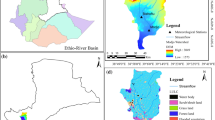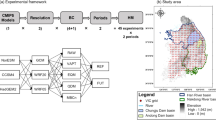Abstract
Climate change may affect water resources by altering various processes in natural ecosystems. Dynamic and statistical downscaling methods are commonly used to assess the impacts of climate change on water resources. Objectively, both methods have their own advantages and disadvantages. In the present study, we assessed the impacts of climate change on water resources during the future periods (2020–2029 and 2040–2049) in the upper reaches of the Kaidu River Basin, Xinjiang, China, and discussed the uncertainties in the research processes by integrating dynamic and statistical downscaling methods (regional climate models (RCMs) and general circulation modes (GCMs)) and utilizing these outputs. The reference period for this study is 1990–1999. The climate change trend is represented by three bias-corrected RCMs (i.e., Hadley Centre Global Environmental Model version 3 regional climate model (HadGEM3-RA), Regional Climate Model version 4 (RegCM4), and Seoul National University Meso-scale Model version 5 (SUN-MM5)) and an ensemble of GCMs on the basis of delta change method under two future scenarios (RCP4.5 and RCP8.5). We applied the hydrological SWAT (Soil and Water Assessment Tool) model which uses the RCMs/GCMs outputs as input to analyze the impacts of climate change on the stream flow and peak flow of the upper reaches of the Kaidu River Basin. The simulation of climate factors under future scenarios indicates that both temperature and precipitation in the study area will increase in the future compared with the reference period, with the largest increase of annual mean temperature and largest percentage increase of mean annual precipitation being of 2.4°C and 38.4%, respectively. Based on the results from bias correction of climate model outputs, we conclude that the accuracy of RCM (regional climate model) simulation is much better for temperature than for precipitation. The percentage increase in precipitation simulated by the three RCMs is generally higher than that simulated by the ensemble of GCMs. As for the changes in seasonal precipitation, RCMs exhibit a large percentage increase in seasonal precipitation in the wet season, while the ensemble of GCMs shows a large percentage increase in the dry season. Most of the hydrological simulations indicate that the total stream flow will decrease in the future due to the increase of evaporation, and the maximum percentage decrease can reach up to 22.3%. The possibility of peak flow increasing in the future is expected to higher than 99%. These results indicate that less water is likely to be available in the upper reaches of the Kaidu River Basin in the future, and that the temporal distribution of flow may become more concentrated.
Similar content being viewed by others
References
Bellouin N, Collins W J, Culverwell I D, et al. 2011. The HadGEM2 family of met office unified model climate configurations. Geoscientific Model Development, 4: 723–757.
Busuioc A, Giorgi F, Bi X, et al. 2006. Comparison of regional climate model and statistical downscaling simulations of different winter precipitation change scenarios over Romania. Theoretical and Applied Climatology, 86(1–4): 101–123.
Buytaert W, Vuille M, Dewulf A, et al. 2010. Uncertainties in climate change projections and regional downscaling in the tropical Andes: implications for water resources management. Hydrology and Earth System Sciences Discussions, 14: 1247–1258.
Cha D H, Lee D K. 2014. Reduction of systematic errors in regional climate simulations of the summer monsoon over East Asia and the western North Pacific by applying the spectral nudging technique. Journal of Geophysical Research Atmospheres, 114(D14): 14108, doi: 10.1029/2008JD011176.
Chen J, Brissette F P, Leconte R. 2011. Uncertainty of downscaling method in quantifying the impact of climate change on hydrology. Journal of Hydrology, 401(3–4): 190–202.
Chen Y N, Li Z, Fan Y, et al. 2014. Research progress on the impact of climate change on water resources in the arid region of Northwest China. Acta Geographica Sinica, 69(9): 1295–1304. (in Chinese)
Christensen J H, Carter T R, Rummukainen M, et al. 2007. Evaluating the performance and utility of regional climate models: the PRUDENCE project. Climatic Change, 81: 1–6.
Christensen J H, Christensen O B. 2007. A summary of the PRUDENCE model projections of changes in European climate by the end of this century. Climatic Change, 81: 7–30.
Davies T, Cullen M J P, Malcolm A J, et al. 2005. A new dynamical core for the Met Office’s global and regional modelling of the atmosphere. Quarterly Journal of the Royal Meteorological Society, 131: 1759–1782.
Dimitropoulos X, Hurley P, Kind A, et al. 2009. On the 95-percentile billing method. In: Moon S B, Teixeira R, Uhlig S. Passive and Active Network Measurement.
PAM 2009. Lecture Notes in Computer Science, vol. 5448. Berlin: Springer, 207–216.
Fang G H, Yang J, Chen Y N, et al. 2015. Comparing bias correction methods in downscaling meteorological variables for a hydrologic impact study in an arid area in China. Hydrology and Earth System Sciences, 19: 2547–2559.
Foley A M. 2010. Uncertainty in regional climate modelling: a review. Progress in Physical Geography, 34(5): 647–670.
Fu C, Wang S, Xiong Z, et al. 2005. Regional climate model intercomparison project for Asia. Bulletin of the American Meteorological Society, 86(2): 257–266.
Fu G, Charles S P, Chiew F H, et al. 2011. Statistical of gridded rainfall and their impacts on hydrological response analysis. AGU Fall Meeting. Washington, D.C.: American Geophysical Union.
Geng H J. 2002. Study and application of Excel in P-III distribution frequency calculation. Hydroelectric Energy, 20(3): 41–43. (in Chinese)
Giorgi F, Jones C, Asrar G R. 2009. Addressing climate information needs at the regional level: the CORDEX framework. World Meteorological Organization Bulletin, 58(3): 175–183.
Giorgi F, Coppola E, Solmon F, et al. 2012. RegCM4: Model description and preliminary tests over multiple CORDEX domains. Climate Research, 52: 7–29.
Handel M D, Risbey J S. 1992. An annotated bibliography on the greenhouse effect and climate change. Climatic Change, 21(2): 97–255.
Hewitt C D. 2004. Ensembles-based predictions of climate changes and their impacts. Eos Transactions American Geophysical Union, 85(52): 566–566.
Jiang S, Ren L, Yong B, et al. 2011. Quantifying the effects of climate variability and human activities on runoff from the Laohahe basin in northern China using three different methods. Hydrological Processes, 25(16): 2492–2505.
Lana M A, Eulenstein F, Schlindwein S, et al. 2016. Regionalization of climate scenarios impacts on maize production and the role of cultivar and planting date as an adaptation strategy. Regional Environmental Change, 16(5): 1319–1331.
Landman W. 2007. Climate change 2007: the physical science basis. South African Geographical Journal, 92(1): 86–87.
Lenderink G, Buishand A, van Deursen W. 2007. Estimates of future discharges of the river Rhine using two scenario methodologies: direct versus delta approach. Hydrology and Earth System Sciences, 11: 1145–1159.
Liu T, Willems P, Pan X L, et al. 2011. Climate change impact on water resource extremes in a headwater region of the Tarim basin in China. Hydrology and Earth System Sciences, 15: 3511–3527.
Liu X, Shen Y, Li H, et al. 2017. Estimation of land surface evapotranspiration over complex terrain based on multi-spectral remote sensing data. Hydrological Processes, 31(2): 446–461.
Mearns L O, Bogardi I, Giorgi F, et al. 1999. Comparison of climate change scenarios generated from regional climate model experiments and statistical downscaling. Journal of Geophysical Research Atmospheres, 104(D6): 6603–6621.
Mupenzi J D L P, Li L. 2011. Impacts of global warming perturbation on water resources in arid zone: Case study of Kaidu River Basin in Northwest China. Journal of Mountain Science, 8: 704–710.
Onyutha C, Tabari H, Rutkowska A, et al. 2016. Comparison of different statistical downscaling methods for climate change rainfall projections over the Lake Victoria basin considering CMIP3 and CMIP5. Journal of Hydro-environment Research, 12: 31–45.
Ouyang F, Lü H S, Zhu Y H, et al. 2014. Uncertainty analysis of downscaling methods in assessing the influence of climate change on hydrology. Stochastic Environmental Research and Risk Assessment, 28(4): 991–1010.
Ouyang F, Zhu Y, Fu G B, et al. 2015. Impacts of climate change under CMIP5 RCP scenarios on streamflow in the Huangnizhuang catchment. Stochastic Environmental Research and Risk Assessment, 29(7): 1781–1795.
Rahman K, Etienne C, Gago-Silva A, et al. 2014. Streamflow response to regional climate model output in the mountainous watershed: a case study from the Swiss Alps. Environmental Earth Sciences, 72(11): 4357–4369.
Sachindra D A, Huang F, Barton A F, et al. 2014. Multi-model ensemble approach for statistically downscaling general circulation model outputs to precipitation. Quarterly Journal of the Royal Meteorological Society, 140: 1161–1178.
Schmidli J, Frei C, Vidale P L. 2006. Downscaling from GCM precipitation: a benchmark for dynamical and statistical downscaling methods. International Journal of Climatology, 26(5): 679–689.
Sivapalan M, Takeuchi K, Franks S W, et al. 2003. IAHS Decade on Predictions in Ungauged Basins (PUB), 2003–2012. Shaping an exciting future for the hydrological sciences. Hydrological Sciences Journal, 48(6): 857–880.
Solomon S, Qin D, Manning M, et al. 2007. The Physical Science Basis. Contribution of Working Group I to the Fourth Assessment Report of the Intergovernmental Panel on Climate Change. Cambridge: Cambridge University Press, 95–123.
Taylor K E, Stouffer R J, Meehl G A. 2011. An overview of CMIP5 and the experiment design. Bulletin of the American Meteorological Society, 93(4): 485–498.
Wang W X, Wang X J, Jiang F Q, et al. 2013. Response of runoff volume to climate change in the Kaidu River Basin in recent 30 years. Arid Zone Research, 30(4): 743–748. (in Chinese)
Wehner M F. 2013. Very extreme seasonal precipitation in the NARCCAP ensemble: model performance and projections. Climate Dynamics, 40(1–2): 59–80.
Wilby R L, Hay L E, Gutowski W J, et al. 2000. Hydrological responses to dynamically and statistically downscaled climate model output. Geophysical Research Letters, 27(8): 1199–1202.
Xu C C, Zhao J, Deng H J, et al. 2016. Scenario-based runoff prediction for the Kaidu River basin of the Tianshan Mountains, Northwest China. Environmental Earth Sciences, 75: 1126, doi: 10.1007/s12665-016-5930-9.
Xu C Y, Singh V P. 2004. Review on regional water resources assessment models under stationary and changing climate. Water Resources Management, 18(6): 591–612.
Xu J, Chen Y N, Ji M, et al. 2008. Climate change and its effects on runoff of Kaidu River, Xinjiang, China: A multiple time-scale analysis. Chinese Geographical Science, 18(4): 331–339.
Xue J, Lei J Q, Gui D W, et al. 2016. Synchronism of runoff response to climate change in Kaidu River Basin in Xinjiang, Northwest China. Sciences in Cold and Arid Regions, 8(1): 82–94.
Yang Q, Cui C. 2005. Impact of climate change on the surface water of Kaidu River Basin. Journal of Geographical Sciences, 15(1): 20–28.
Zhang H, Huang G H. 2013. Development of climate change projections for small watersheds using multi-model ensemble simulation and stochastic weather generation. Climate Dynamics, 40(3–4): 805–821.
Zhang Y N, Xu C C, Li W H, et al. 2014. Climate change characteristics and impacts on surface runoff in the Kaidu River Basin. Science of Soil and Water Conservation, 12(1): 81–89. (in Chinese)
Acknowledgments
This research was supported by the Natural Science Foundation of Xinjiang Uygur Autonomous Region (2015211B031). We wish to thank the Xinjiang Tarim River Basin Management Bureau and the Xinjiang Meteorological Administration for providing the necessary data to build the Soil and Water Assessment Tool (SWAT) model. We also grateful for the Coordinated Regional Downscaling Experiment-East Asia (CORDEX-EA) project and the Coupled Model Inter-comparison Project Phase 5 (CMIP5) project for providing dynamic downscaling RCMs and GCMs data free of charge.
Author information
Authors and Affiliations
Corresponding author
Rights and permissions
About this article
Cite this article
Ba, W., Du, P., Liu, T. et al. Simulating hydrological responses to climate change using dynamic and statistical downscaling methods: a case study in the Kaidu River Basin, Xinjiang, China. J. Arid Land 10, 905–920 (2018). https://doi.org/10.1007/s40333-018-0068-0
Received:
Revised:
Accepted:
Published:
Issue Date:
DOI: https://doi.org/10.1007/s40333-018-0068-0




